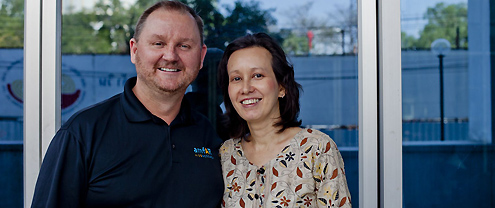Investigator Profile: Dr. Jintanat Ananworanich’s Search for the Cure
Published July 2014

Dr. Ananworanich with amfAR CEO Kevin Robert Frost
Dr. Jintanat Ananworanich, a TREAT Asia and amfAR investigator, is leading some of the most exciting adult and pediatric HIV cure research occurring in the world today. Her studies are investigating how and if getting patients on antiretroviral therapy (ART) as soon after infection as possible can reliably increase their likelihood of achieving a functional HIV cure, or HIV remission—meaning that HIV remains virtually undetectable in the blood even after the patient stops treatment. Earlier this year, she received a prestigious R01 research grant from the U.S. National Institute of Allergy and Infectious Diseases (NIAID) to expand her pediatric work.
Dr. Ananworanich has been working as a pediatrician and clinical researcher at the Thai Red Cross AIDS Research Centre since 2000, and in February of this year she joined the U.S. Military HIV Research Program (MHRP) as associate director for therapeutics research. “Dr. Jintanat’s work in infants and adults is providing critical knowledge mapping out strategies to attempt a functional cure for HIV infection,” says Colonel Nelson Michael, M.D., Ph.D., director of MHRP.
Unlike most cure-related HIV research happening today, Dr. Ananworanich’s groundbreaking studies are occurring in a country that bears a heavy disease burden. “We know that the majority of people living with HIV live in low- and middle-income countries, but the HIV cure research right now is very much concentrated in resource-rich settings,” she says. “However, it is important for low- and middle-income countries to be involved, particularly because the type of HIV they are infected with may be different.” Colonel Michael agrees, saying, “Performing research in countries that will be in a position to most quickly benefit from findings is also a core bioethical principle for study site selection."
Dr. Ananworanich is working in collaboration with both the Thai Red Cross and MHRP to study the effects of getting HIV-positive adults on ART during the first few weeks after infection, a period known as acute infection. Last year, it was reported that 14 adults in France, known as the VISCONTI cohort, who started ART during acute infection have been off treatment for an average of seven years without HIV levels increasing in their blood.
The Thai study aims to better understand how this remission might have occurred and if it can be replicated on a wider scale. There are currently 190 patients in the Thai study and the patients have very little HIV present in their T-cells or other areas of the body where reservoirs of HIV tend to persist even after patients have initiated ART. It is the inability to eradicate these reservoirs that has made HIV so difficult to cure. Dr. Ananworanich says she is optimistic that her patients are among the best candidates for HIV remission, though the researchers do not plan to perform studies that take the patients off ART until they have been on treatment for at least two to three years.
“The identification of people so early in infection, and treating them right away, makes this a truly unique opportunity to learn more about how reservoirs are established and how they might be removed,” says Rowena Johnston, amfAR vice president and director of research. In addition to working with amfAR’s TREAT Asia program, Dr. Ananworanich has also received a grant through amfAR’s Research Consortium on HIV Eradication (ARCHE) program for her work on a study led by Dr. Nicolas Chomont, of the Vaccine and Gene Therapy Institute in Port St. Lucie, Florida, investigating the persistence of these viral reservoirs.
In June 2012, Dr. Ananworanich attended a pediatric cure think tank organized by amfAR at the University of California, San Francisco, that brought together leading scientists involved in various aspects of HIV cure research to discuss strategies for curing HIV in infants and children. “I think amfAR was really a leader in setting up the pediatric cure think tank,” she says. “It was very early on, before the Mississippi baby, when the field was not really focused on finding a pediatric cure.” The Mississippi baby was placed on ART at birth, but stopped receiving it for two years. Although the child is now back on ART, this was the first case of an individual living so long off treatment without detectable HIV virus.
“It was through that meeting that the U.S. National Institute of Child Health and Human Development and NIAID came out with a call for grant applications looking at reservoir size and latent reservoirs in early treated children,” she says. As a result of that call, Dr. Ananworanich received the R01 from NIAID to expand the scope of her pediatric cure research. The study has created a broad collaboration with the Thai Ministry of Public Health, the Thai Red Cross, and MHRP to attempt to identify infants born to HIV-positive mothers not receiving ART as soon after birth as possible, and immediately putting the infants on treatment. If they later test positive, they will continue their treatment without interruption.
Dr. Ananworanich estimates that over the five years of the study, the team will enroll about 80 infants who were started on ART at birth and an additional 180 HIV-positive infants who were not identified until some time after birth and then put on treatment. “What we are doing is trying to measure the amount of virus hidden in their white blood cells and see if this virus can replicate or increase in number,” she says. “We are looking at that before and after treatment is initiated, and we are also looking at the body’s reaction to the virus, in terms of immunity, so we can understand what really happens in babies in terms of early treatment and how it curbs the amount of virus in the body. It is very exciting.”